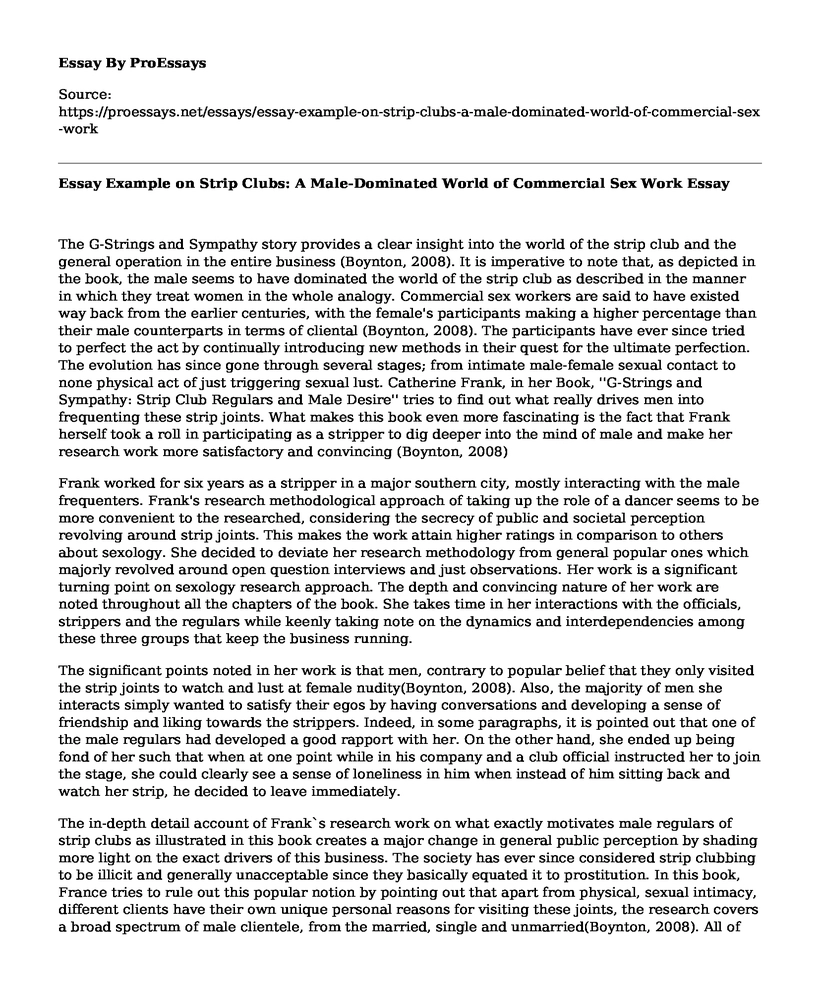The G-Strings and Sympathy story provides a clear insight into the world of the strip club and the general operation in the entire business (Boynton, 2008). It is imperative to note that, as depicted in the book, the male seems to have dominated the world of the strip club as described in the manner in which they treat women in the whole analogy. Commercial sex workers are said to have existed way back from the earlier centuries, with the female's participants making a higher percentage than their male counterparts in terms of cliental (Boynton, 2008). The participants have ever since tried to perfect the act by continually introducing new methods in their quest for the ultimate perfection. The evolution has since gone through several stages; from intimate male-female sexual contact to none physical act of just triggering sexual lust. Catherine Frank, in her Book, ''G-Strings and Sympathy: Strip Club Regulars and Male Desire'' tries to find out what really drives men into frequenting these strip joints. What makes this book even more fascinating is the fact that Frank herself took a roll in participating as a stripper to dig deeper into the mind of male and make her research work more satisfactory and convincing (Boynton, 2008)
Frank worked for six years as a stripper in a major southern city, mostly interacting with the male frequenters. Frank's research methodological approach of taking up the role of a dancer seems to be more convenient to the researched, considering the secrecy of public and societal perception revolving around strip joints. This makes the work attain higher ratings in comparison to others about sexology. She decided to deviate her research methodology from general popular ones which majorly revolved around open question interviews and just observations. Her work is a significant turning point on sexology research approach. The depth and convincing nature of her work are noted throughout all the chapters of the book. She takes time in her interactions with the officials, strippers and the regulars while keenly taking note on the dynamics and interdependencies among these three groups that keep the business running.
The significant points noted in her work is that men, contrary to popular belief that they only visited the strip joints to watch and lust at female nudity(Boynton, 2008). Also, the majority of men she interacts simply wanted to satisfy their egos by having conversations and developing a sense of friendship and liking towards the strippers. Indeed, in some paragraphs, it is pointed out that one of the male regulars had developed a good rapport with her. On the other hand, she ended up being fond of her such that when at one point while in his company and a club official instructed her to join the stage, she could clearly see a sense of loneliness in him when instead of him sitting back and watch her strip, he decided to leave immediately.
The in-depth detail account of Frank`s research work on what exactly motivates male regulars of strip clubs as illustrated in this book creates a major change in general public perception by shading more light on the exact drivers of this business. The society has ever since considered strip clubbing to be illicit and generally unacceptable since they basically equated it to prostitution. In this book, France tries to rule out this popular notion by pointing out that apart from physical, sexual intimacy, different clients have their own unique personal reasons for visiting these joints, the research covers a broad spectrum of male clientele, from the married, single and unmarried(Boynton, 2008). All of these groups have their own different reasons for visiting these joints, ranging from feeling excited, boosting their ego and also experiencing erotic fantasies. In this era of HIV pandemic, one would hardly associate themselves to a strip club. This is because strip clubbing has always been considered synonymous to the sex trade. Thus this book is an eye-opener to those who blindly followed this traditional notion without carrying out fact-finding as has been done by the author. Frank by detailing her experience with the regulars in the form of sexual fantasy stories, she creates a pleasant atmosphere a kind of real experience to the reader. This makes the reader to be intimately attached to the book and with a lot of liking.
While the book tends to majorly focus on why male regulars tend to frequent these joints, less attention is given to other players such as the fellow strippers, club owners and other indirect players. The book has so far filled an enormous gap left in sexology research and has also raised the bar in terms of how now a research sexologist should go with research findings considering that Frank has gone through general social unacceptable barriers to create this fascinating piece of work. The book provides the best learning resource material especially to the young generation who apart from learning, experience these findings first hand.
References
Boynton, P. (2008). A Review of:"G-Strings and Sympathy: Strip Club Regulars and Male Desire" by Katherine Frank. Durham and London: Due University Press, 2002.
Cite this page
Essay Example on Strip Clubs: A Male-Dominated World of Commercial Sex Work. (2022, Dec 29). Retrieved from https://proessays.net/essays/essay-example-on-strip-clubs-a-male-dominated-world-of-commercial-sex-work
If you are the original author of this essay and no longer wish to have it published on the ProEssays website, please click below to request its removal:
- Research Paper on Jealousy and Relationship Satisfaction
- Counter-Terrorism, Security, and Intelligence Essay
- Essay Sample on Women's Movement
- Criminology and Domestic Violence in UK Essay Example
- The Trial of the Brett Kavanaugh vs. Christine Ford - Essay Sample
- Paper Example on Human Trafficking: Millions Trafficked Illegally Each Year
- Essay on Breach of Social Norms: A Sociological Experiment on Personal Space Invasion in Supermarket Queues







